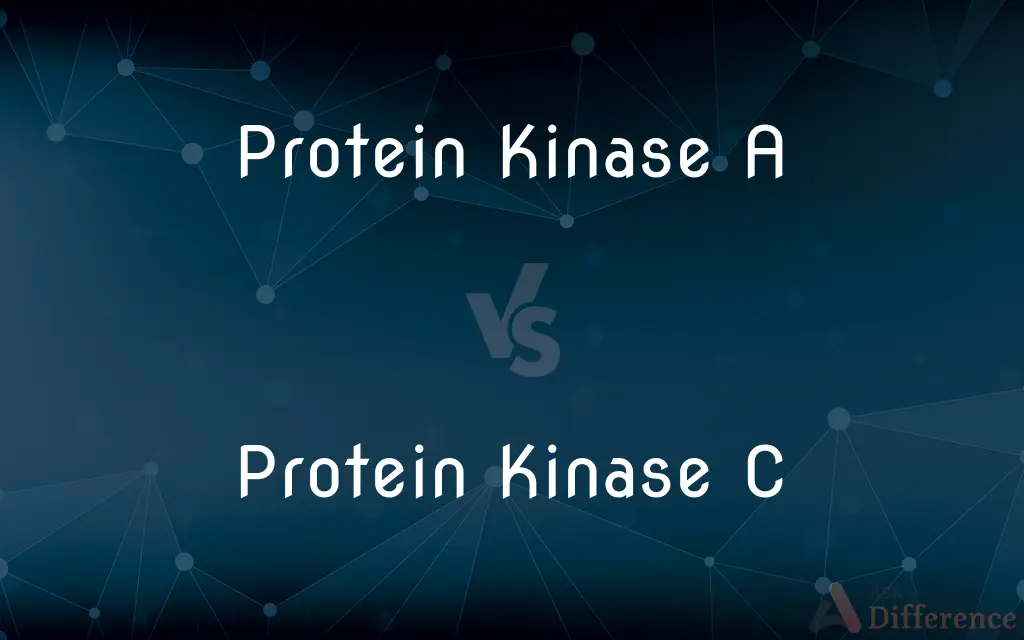Protein Kinase A vs. Protein Kinase C — What's the Difference?
By Tayyaba Rehman — Published on November 11, 2023
Protein Kinase A (PKA) is an enzyme activated by cyclic AMP and is involved in many cellular processes, while Protein Kinase C (PKC) is an enzyme activated by diacylglycerol and calcium ions, participating in signaling pathways.

Difference Between Protein Kinase A and Protein Kinase C
Table of Contents
ADVERTISEMENT
Key Differences
Protein Kinase A (PKA) and Protein Kinase C (PKC) are both crucial kinases in cellular signaling pathways, but they have distinct roles and activation mechanisms. PKA, activated by the molecule cyclic AMP (cAMP), plays a pivotal role in numerous cellular processes, including the regulation of metabolism, gene transcription, and cell cycle progression. In contrast, Protein Kinase C is chiefly activated by diacylglycerol (DAG) in the presence of calcium ions and is involved in diverse cellular responses like cell growth and differentiation.
While both Protein Kinase A and Protein Kinase C can phosphorylate target proteins, thereby regulating their activity, they often target different substrates, leading to different cellular responses. PKA, for instance, can phosphorylate the enzyme glycogen synthase, impacting glucose metabolism. On the other hand, PKC has a hand in modulating immune cell activation by influencing the activity of certain ion channels.
The regulation of both these kinases is multifaceted. For Protein Kinase A, cAMP binds to its regulatory subunits, causing a conformational change and releasing its catalytic subunits to be active. In the case of Protein Kinase C, its activation involves its translocation to the plasma membrane, where it can be activated by DAG and calcium.
In terms of their structural aspects, both kinases have unique domains that allow them to interact with specific molecules and substrates. Protein Kinase A possesses a regulatory and a catalytic subunit, while Protein Kinase C features a C-terminal and an N-terminal region with distinct roles in its activation and function.
In the broader context of human health, understanding the roles and regulation of Protein Kinase A and Protein Kinase C is essential. Both kinases have implications in various diseases, including cancer, making them targets for therapeutic interventions.
ADVERTISEMENT
Comparison Chart
Activation Molecule
Cyclic AMP (cAMP)
Diacylglycerol (DAG) and calcium ions
Key Functions
Regulates metabolism, gene transcription, cell cycle
Involved in cell growth, differentiation, immune cell activation
Structural Features
Regulatory and catalytic subunits
C-terminal and N-terminal regions
Cellular Responses
Influences glucose metabolism
Modulates activity of certain ion channels
Disease Implications
Role in various disorders including heart diseases
Implicated in conditions like cancer and autoimmune diseases
Compare with Definitions
Protein Kinase A
Contains regulatory and catalytic subunits.
The binding of cAMP to Protein Kinase A causes the release of its catalytic subunits.
Protein Kinase C
Activated by DAG and calcium ions.
In the presence of elevated calcium, Protein Kinase C becomes active, modulating various cellular functions.
Protein Kinase A
A kinase impacting metabolism and transcription.
Protein Kinase A can influence the rate of gene expression in cells.
Protein Kinase C
Possesses distinct structural regions for its function.
The N-terminal of Protein Kinase C contains domains essential for its activation.
Protein Kinase A
An enzyme regulated by cAMP.
Upon hormonal stimulation, the levels of cAMP rise, activating Protein Kinase A.
Protein Kinase C
Involved in diverse cellular signaling events.
Protein Kinase C plays a role in inflammatory responses by influencing immune cell functions.
Protein Kinase A
Implicated in various human diseases.
Abnormalities in Protein Kinase A signaling can contribute to certain cardiac conditions.
Protein Kinase C
A kinase with roles in cell growth and differentiation.
Protein Kinase C influences the growth signals in certain cancer cells.
Protein Kinase A
A participant in many signaling pathways.
Protein Kinase A plays a role in the signaling cascade triggered by certain hormones.
Protein Kinase C
Has been targeted in therapeutic interventions.
Some cancer therapies aim at modulating Protein Kinase C activity to halt tumor growth.
Common Curiosities
Are Protein Kinase A and Protein Kinase C involved in any common signaling pathways?
Yes, both PKA and PKC play roles in diverse cellular signaling pathways and can sometimes intersect or influence the same pathways, depending on the cellular context.
What are the major activators of Protein Kinase C in cells?
Protein Kinase C is majorly activated by diacylglycerol (DAG) and calcium ions.
How does Protein Kinase A influence glucose metabolism?
Protein Kinase A can phosphorylate enzymes like glycogen synthase, impacting the conversion of glucose into glycogen.
What is the primary function of Protein Kinase A in cells?
Protein Kinase A (PKA) regulates various cellular processes, including metabolism, gene transcription, and cell cycle progression.
Can inhibitors of Protein Kinase A or Protein Kinase C be used therapeutically?
Yes, specific inhibitors targeting these kinases are researched for potential therapeutic uses, especially in diseases like cancer.
How does Protein Kinase C differ in its activation compared to Protein Kinase A?
While Protein Kinase A is primarily activated by cyclic AMP (cAMP), Protein Kinase C (PKC) is activated by diacylglycerol (DAG) in conjunction with calcium ions.
Can abnormalities in Protein Kinase A signaling impact health?
Yes, disruptions in Protein Kinase A signaling have implications in various diseases, including certain heart conditions and tumors.
Why is Protein Kinase C studied in the context of cancer?
Protein Kinase C is involved in cell growth and differentiation, and its abnormal activation or expression can contribute to cancerous growths.
How does cyclic AMP (cAMP) influence Protein Kinase A activity?
cAMP binds to the regulatory subunits of Protein Kinase A, causing a conformational change that releases and activates its catalytic subunits.
Are there different forms or isoforms of Protein Kinase A and Protein Kinase C in cells?
Yes, both Protein Kinase A and Protein Kinase C have multiple isoforms with specific tissue distributions and functions.
Do Protein Kinase A and Protein Kinase C target the same proteins inside cells?
While they can phosphorylate some common substrates, PKA and PKC generally have unique target proteins, leading to different cellular outcomes.
Why is Protein Kinase C important for immune responses?
Protein Kinase C modulates the activation of certain immune cells and influences the production of inflammatory mediators.
Share Your Discovery

Previous Comparison
Internal Control vs. Internal Audit
Next Comparison
Phthalic Acid vs. Terephthalic AcidAuthor Spotlight
Written by
Tayyaba RehmanTayyaba Rehman is a distinguished writer, currently serving as a primary contributor to askdifference.com. As a researcher in semantics and etymology, Tayyaba's passion for the complexity of languages and their distinctions has found a perfect home on the platform. Tayyaba delves into the intricacies of language, distinguishing between commonly confused words and phrases, thereby providing clarity for readers worldwide.












































